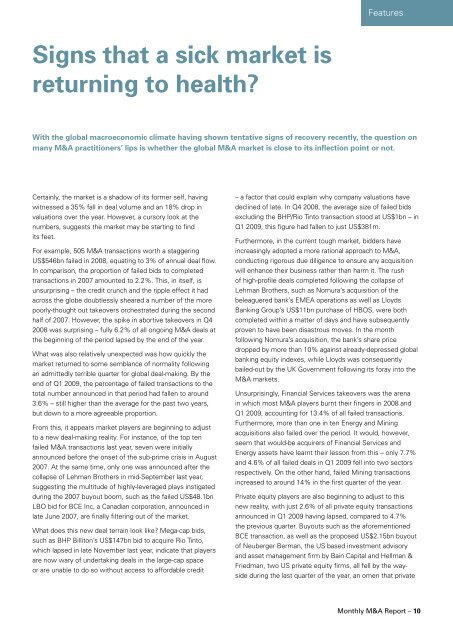Monthly M&A Insider - Mergermarket
Monthly M&A Insider - Mergermarket
Monthly M&A Insider - Mergermarket
You also want an ePaper? Increase the reach of your titles
YUMPU automatically turns print PDFs into web optimized ePapers that Google loves.
Signs that a sick market is<br />
returning to health?<br />
Features<br />
With the global macroeconomic climate having shown tentative signs of recovery recently, the question on<br />
many M&A practitioners’ lips is whether the global M&A market is close to its inflection point or not.<br />
Certainly, the market is a shadow of its former self, having<br />
witnessed a 35% fall in deal volume and an 18% drop in<br />
valuations over the year. However, a cursory look at the<br />
numbers, suggests the market may be starting to find<br />
its feet.<br />
For example, 505 M&A transactions worth a staggering<br />
US$546bn failed in 2008, equating to 3% of annual deal flow.<br />
In comparison, the proportion of failed bids to completed<br />
transactions in 2007 amounted to 2.2%. This, in itself, is<br />
unsurprising – the credit crunch and the ripple effect it had<br />
across the globe doubtlessly sheared a number of the more<br />
poorly-thought out takeovers orchestrated during the second<br />
half of 2007. However, the spike in abortive takeovers in Q4<br />
2008 was surprising – fully 6.2% of all ongoing M&A deals at<br />
the beginning of the period lapsed by the end of the year.<br />
What was also relatively unexpected was how quickly the<br />
market returned to some semblance of normality following<br />
an admittedly terrible quarter for global deal-making. By the<br />
end of Q1 2009, the percentage of failed transactions to the<br />
total number announced in that period had fallen to around<br />
3.6% – still higher than the average for the past two years,<br />
but down to a more agreeable proportion.<br />
From this, it appears market players are beginning to adjust<br />
to a new deal-making reality. For instance, of the top ten<br />
failed M&A transactions last year, seven were initially<br />
announced before the onset of the sub-prime crisis in August<br />
2007. At the same time, only one was announced after the<br />
collapse of Lehman Brothers in mid-September last year,<br />
suggesting the multitude of highly-leveraged plays instigated<br />
during the 2007 buyout boom, such as the failed US$48.1bn<br />
LBO bid for BCE Inc, a Canadian corporation, announced in<br />
late June 2007, are finally filtering out of the market.<br />
What does this new deal terrain look like? Mega-cap bids,<br />
such as BHP Billiton’s US$147bn bid to acquire Rio Tinto,<br />
which lapsed in late November last year, indicate that players<br />
are now wary of undertaking deals in the large-cap space<br />
or are unable to do so without access to affordable credit<br />
– a factor that could explain why company valuations have<br />
declined of late. In Q4 2008, the average size of failed bids<br />
excluding the BHP/Rio Tinto transaction stood at US$1bn – in<br />
Q1 2009, this figure had fallen to just US$381m.<br />
Furthermore, in the current tough market, bidders have<br />
increasingly adopted a more rational approach to M&A,<br />
conducting rigorous due diligence to ensure any acquisition<br />
will enhance their business rather than harm it. The rush<br />
of high-profile deals completed following the collapse of<br />
Lehman Brothers, such as Nomura’s acquisition of the<br />
beleaguered bank’s EMEA operations as well as Lloyds<br />
Banking Group’s US$11bn purchase of HBOS, were both<br />
completed within a matter of days and have subsequently<br />
proven to have been disastrous moves. In the month<br />
following Nomura’s acquisition, the bank’s share price<br />
dropped by more than 10% against already-depressed global<br />
banking equity indexes, while Lloyds was consequently<br />
bailed-out by the UK Government following its foray into the<br />
M&A markets.<br />
Unsurprisingly, Financial Services takeovers was the arena<br />
in which most M&A players burnt their fingers in 2008 and<br />
Q1 2009, accounting for 13.4% of all failed transactions.<br />
Furthermore, more than one in ten Energy and Mining<br />
acquisitions also failed over the period. It would, however,<br />
seem that would-be acquirers of Financial Services and<br />
Energy assets have learnt their lesson from this – only 7.7%<br />
and 4.6% of all failed deals in Q1 2009 fell into two sectors<br />
respectively. On the other hand, failed Mining transactions<br />
increased to around 14% in the first quarter of the year.<br />
Private equity players are also beginning to adjust to this<br />
new reality, with just 2.6% of all private equity transactions<br />
announced in Q1 2009 having lapsed, compared to 4.7%<br />
the previous quarter. Buyouts such as the aforementioned<br />
BCE transaction, as well as the proposed US$2.15bn buyout<br />
of Neuberger Berman, the US based investment advisory<br />
and asset management firm by Bain Capital and Hellman &<br />
Friedman, two US private equity firms, all fell by the wayside<br />
during the last quarter of the year, an omen that private<br />
<strong>Monthly</strong> M&A Report – 10




![mergermarket [TITLE OF RELEASE TO GO HERE] 3 January 2013 ...](https://img.yumpu.com/11701841/1/190x135/mergermarket-title-of-release-to-go-here-3-january-2013-.jpg?quality=85)












